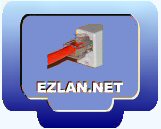|
EZLAN.NET
Copyright © 2001-2008
|
Hardware and Software Specifications, Examples, Links, and other info. are valid at the publishing time. In case it become invalid use the Internet Search. 1st Published, Dec. 2004 Over 9,000,000 Hits Site Wide in 2007 
Wireless Network - Hardware Configuration Modes. Entry Level Wireless Cable/DSL Routers cost the same or, less than Entry Level Access Points. Seemingly it is a better deal since you get for the price an additional Router and a 4 ports Switch. The draw back is the settings. Almost all Wireless Cable/DSL Routers are set "fix" in Gateway Mode, while Access Point can be configured in few ways. This means that if you need a flexible system with room for expansion you are better off with a good Access Point. Access Point (AP) Configurations: Mode 1 - Gateway. This is the most prevalent mode of all Entry Level Cable/DSL Routers, and Access Points. In this mode the hardware acts as a Wireless Hub connecting to Wireless Clients that are installed on network computers (Wireless PCMCIA, Wireless USB, Wireless PCI, etc.). Mode 2 - Bridge. Most APs can also be configured as a Bridge. In such Configuration the AP can only communicate with another AP that is configured as a Bridge. This mode is useful to Bridge two LAN segments that are apart, and it is preferred to connect them wirelessly. Plug one AP Bridge to a Switch on the first LAN, the other AP to a Switch on the second LAN, and they are connected. Mode 3 - Client. Few APs can also be configured as Clients. In such a configuration they act as a "Fancy" regular Wireless card that usually goes on a computer. Under such configuration The AP can only communicate with Wireless Cable/DSL Router or an AP configured as a Gateway. Mode 4 - Repeater. Few Entry Level APs (D-Link 900AP+, Linksys WAP11) can work as a Repeaters. It acts like a client to receive a signal a Wireless source (regular Wireless Router, or AP), and then switches to AP mode to broadcasts to regular clients. Such a configuration can be used to extend the range of a Wireless LAN. When Access Point is used in Client Mode, or configured as a Repeater it is advisable to use hardware of the same Brand. While normal 802.11b or 802.11g are highly compatible between brands, all the special modes hardware like 802.11b+, 802.11gSuper etc. are only compatible with the same brand Hardware, or similar Hardware that uses same the version of the chipset. Since basic Repeaters have only one Radio it alternates between Client and AP mode, thus reduces the "Speed" of the extended segment by 50%. Mode 5 - Independent Bridges. These are units that are actually Wireless clients Independent of Drivers (Driverless Wireless Client Cards). As a result they can be connected to a device that supports Wireless but it is not a regular computer. They can turn Ethernet equipped like Printers and Game Boxes into Wireless compatible devices. (Linksys WET11, D-Link DWL-810). Plug one of these into a Switch and you can connect few computers with wires to the switch while these computers are Bridged Wirelessly to the main Network. The word Bridge, as used for marketing purposes by the manufactures to describe this hardware is somewhat misleading. These “Gizmos” are Drivers Independent Client Modules. Let capture. Mode 1 can only communicate with Mode 3. Mode 2 can only communicate with Mode 2. Mode 3 can communicate with Mode 1. Mode 4 can communicate with Mode 1, and Mode 3. Mode 5 can communicate with Mode 1 (and Mode 2 if it can be configured as a real bridge). As far as I know, the Wireless part of almost all the Wireless Cable/DSL Routers is hard set as Gateway, and can not be configured as Bridges. I.e. one Wireless Cable/DSL Router will not talk Wirelessly to another Wireless Cable/DSL Router. Recently some of the New releases come with more flexible Wireless Routers (namely Buffalo Tech. and Belkin, and few others). This type of Wireless Hardware is referred to as WDS. WDS stands for Wireless Distribution System Basically it means that the hardware can be configured to Modes 1, 2, 3, and 4 as described above. If you need any of the additional Modes check carefully the Data Sheet of the product, and make sure that it is describe as WDS capable.
Example:
from
http://www.buffalotech.com/files/products/WHR-G54S_DS_101905.pdf
|